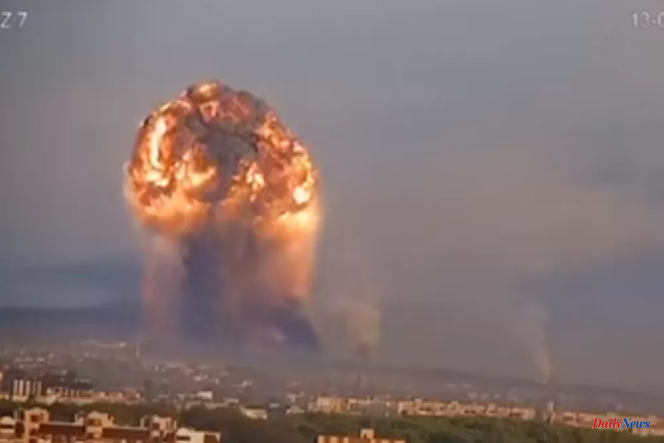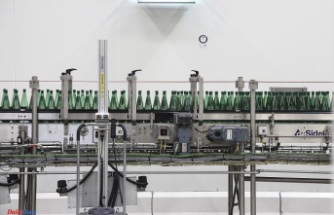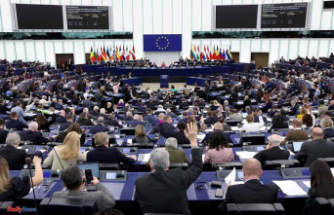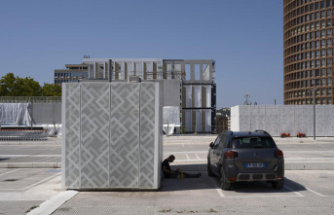"Khmelnytsky's explosion freaked out all the Geiger counters," one tweet read. "It's not Russia that should be blamed but London, who provided these junk depleted uranium shells," adds one Internet user. "Perhaps the first modern case of (mini) nuclear strike against oneself", laughs a third. According to Russia and its megaphones, Europe would be facing a boomerang return the size of a radioactive cloud, since the spectacular explosion that occurred on the night of May 12 to 13 in Khmelnytsky, in the center of Ukraine. Depleted uranium particles in suspension would then head west and have already reached Poland – a scenario that evokes the Chernobyl disaster in 1986.
These alarmist publications are based on three assertions:
“We are in the field of communication warfare, sums up Patrice Bouveret, director of the Armaments Observatory. Russia is trying to instill fear in countries close to Ukraine to dissuade them from supporting it. »
1 – The contents of the exploded deposit are not known
At dawn on May 13, a Russian drone caused a spectacular explosion in Khmelnytsky. Ukrainian local administration admits "critical infrastructure" was destroyed; while Moscow refers to an "Armed Forces of Ukraine ammunition depot". The Russian version grew in the following days: it would be ammunition supplied by NATO, in this case depleted uranium shells sent by Great Britain. London committed to it in March, arousing the ire of Vladimir Putin.
The site of the explosion corresponds well to a warehouse of old Soviet ammunition, was able to verify GeoConfirmed, a collective specialized in the geolocation of military strikes. But what it housed at the time of its destruction has not been made public. "We don't know if depleted uranium munitions were delivered, and we don't know if they were present at this location," recalls Bruno Chareyron, nuclear physics engineer and director of the Commission de recherche et d'information laboratory. independent on radioactivity (Criirad).
2 – Depleted uranium is too heavy to form a cloud
The next day, the rumor takes shape. Pro-Russian voices suggest that "something radioactive has exploded". On May 19, the Secretary of the Russian Security Council, Nikolai Patrushev, claimed that the impact would have "caused a radioactive cloud that is heading towards Western Europe", which Poland could have already measured. Russian state media Sputnik headlines "Depleted Uranium Explosion in Ukraine: Europe on the Brink of Environmental Disaster", following a "depleted uranium explosion". The story is repeated on French conspiracy sites.
But the impressive images of the explosion are deceptive. "Radioactivity is invisible, so it's not what forms the fungus. It is the material that is affected on impact, ”corrects Emmanuelle Galichet, lecturer in nuclear science and technology at CNAM, the National Conservatory of Arts and Crafts. The very idea of a radioactive cloud created by depleted uranium is against the laws of physics, she reminds us: this element is not fissionable, and therefore cannot give rise to a nuclear reaction.
Moreover, this artificial derivative of natural uranium is very dense, which makes it very piercing against armor, but also particularly heavy. "He falls to the ground very quickly. What we observe in Zaporijia [where uranium was dispersed under Russian strikes] is that the spraying is very local. It can't make a 'Chernobyl-like' cloud,” Galichet continues. The cloud of the 1986 nuclear disaster was not composed of uranium, but of cesium 137, iodine 131 and ruthenium 103, very volatile radioactive isotopes.
3 – No radioactivity peak in Europe
Finally, what about the peak of radioactivity recorded by a Polish measuring device? "Great nonsense!" “, sweeps Mr. Chareyron. The Russian fake is based on a very real increase in the level of bismuth 214, a product of the decay of natural uranium, but not depleted uranium. The concentration level of Bismuth 214 also fluctuates naturally. "We measure it regularly when it rains, because there is radioactive gas in the atmosphere, radon, which is then brought to the surface," explains the specialist. The Polish nuclear agency confirmed that this increase was not abnormal.
In Western Europe, ten days after the explosion, no detection beacon detected any anomaly. "European countries would have reported it immediately," says Emmanuelle Galichet. The latter have indeed been very vigilant since the Chernobyl disaster and its concealment by the USSR. Thus, in 2020, Finland, Sweden and Norway had communicated on unusual levels of radioactivity of human origin, attributed to Russia. In 2021, a French association reported Saharan sand carrying cesium 137. In May 2023, nothing.
The only exception is a "significant" increase in ambient radioactivity near Khmelnystsky, nuance M. Chareyron. But she was spotted a few days before the explosion, and not where the wind should have carried her. Its cause is unknown. It may be a natural fluctuation, as suggested by Ukrainian officials he interviewed. “But, in a context of doubt like this, it is worth having more precise measurements. »
Real health hazards at the local level
For while the threat of a new "Chernobyl cloud" is not serious, the situation in Ukraine still presents local environmental and health risks. As soon as the delivery of depleted uranium weapons to Kiev was announced, several associations denounced the British decision, such as the NGO Campaign for Nuclear Disarmament, which assured that it was "the last thing the Ukrainians [needed] ".
Admittedly, the radioactivity of depleted uranium is 40% lower than natural uranium, and the alpha rays it emits cannot cross the skin barrier. But it can ignite, for example, by destroying a tank. "This creates dispersion, which people on site can inhale, or which enters the food chain through the contamination of farm animals, soil or groundwater", lists Patrice Bouveret. With the risk of accelerating certain tumors, especially in the lungs and kidneys.
Finally, even if nothing says that missiles promised by London were present on the Khmelnytsky site, "the explosion of ammunition depots inevitably presents health risks, because heavy metals are found in suspension, with or without uranium impoverished,” adds Bruno Chareyron.












